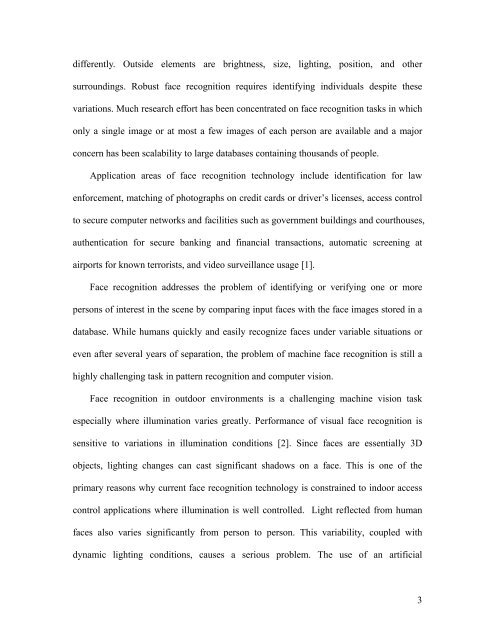Fusion of Visual and Thermal Face Recognition Techniques: A ...
Fusion of Visual and Thermal Face Recognition Techniques: A ...
Fusion of Visual and Thermal Face Recognition Techniques: A ...
You also want an ePaper? Increase the reach of your titles
YUMPU automatically turns print PDFs into web optimized ePapers that Google loves.
differently. Outside elements are brightness, size, lighting, position, <strong>and</strong> other<br />
surroundings. Robust face recognition requires identifying individuals despite these<br />
variations. Much research effort has been concentrated on face recognition tasks in which<br />
only a single image or at most a few images <strong>of</strong> each person are available <strong>and</strong> a major<br />
concern has been scalability to large databases containing thous<strong>and</strong>s <strong>of</strong> people.<br />
Application areas <strong>of</strong> face recognition technology include identification for law<br />
enforcement, matching <strong>of</strong> photographs on credit cards or driver’s licenses, access control<br />
to secure computer networks <strong>and</strong> facilities such as government buildings <strong>and</strong> courthouses,<br />
authentication for secure banking <strong>and</strong> financial transactions, automatic screening at<br />
airports for known terrorists, <strong>and</strong> video surveillance usage [1].<br />
<strong>Face</strong> recognition addresses the problem <strong>of</strong> identifying or verifying one or more<br />
persons <strong>of</strong> interest in the scene by comparing input faces with the face images stored in a<br />
database. While humans quickly <strong>and</strong> easily recognize faces under variable situations or<br />
even after several years <strong>of</strong> separation, the problem <strong>of</strong> machine face recognition is still a<br />
highly challenging task in pattern recognition <strong>and</strong> computer vision.<br />
<strong>Face</strong> recognition in outdoor environments is a challenging machine vision task<br />
especially where illumination varies greatly. Performance <strong>of</strong> visual face recognition is<br />
sensitive to variations in illumination conditions [2]. Since faces are essentially 3D<br />
objects, lighting changes can cast significant shadows on a face. This is one <strong>of</strong> the<br />
primary reasons why current face recognition technology is constrained to indoor access<br />
control applications where illumination is well controlled. Light reflected from human<br />
faces also varies significantly from person to person. This variability, coupled with<br />
dynamic lighting conditions, causes a serious problem. The use <strong>of</strong> an artificial<br />
3
















